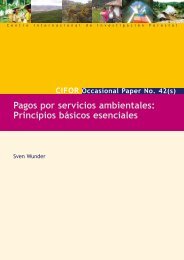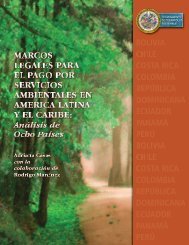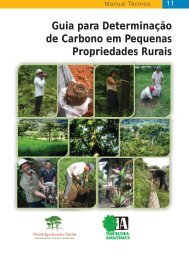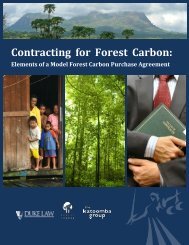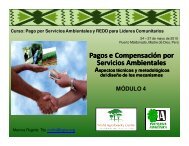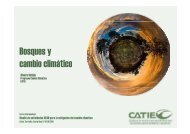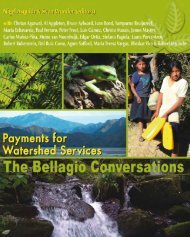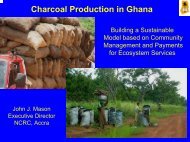Guide on Climate Change and Indigenous Peoples
Guide on Climate Change and Indigenous Peoples
Guide on Climate Change and Indigenous Peoples
- No tags were found...
Create successful ePaper yourself
Turn your PDF publications into a flip-book with our unique Google optimized e-Paper software.
4Reducti<strong>on</strong> of forests as carb<strong>on</strong>forests under REDD underminesthe sustainable forest managementsystems of indigenous peoples<strong>and</strong> threatens further the rights ofindigenous peoples to have access<strong>and</strong> c<strong>on</strong>trol of their forests.*• While Reducing Emissi<strong>on</strong>sfrom Deforestati<strong>on</strong> <strong>and</strong>Forest Degradati<strong>on</strong>(REDD), which is nowbeing proposed to bepart of the post 2012climate agreement, mayhave some opportunitiesfor indigenous peoples who live <strong>and</strong> depend <strong>on</strong> forests, the c<strong>on</strong>cept<strong>and</strong> manner in which it is being shaped <strong>and</strong> implemented posesome problems which have to be addressed seriously.<strong>Indigenous</strong> peoples fear that they will be excluded <strong>on</strong>cemore from their forests as what has happened in theREDD – establishment of Forest Protected Areas in the past. IfReducing their forests are designated as carb<strong>on</strong> forests <strong>and</strong> areEmissi<strong>on</strong>s from used for emissi<strong>on</strong>s trading, there is a great possibilityDeforestati<strong>on</strong>that they will be prevented from practicing their own<strong>and</strong> Foresttraditi<strong>on</strong>al forest management practices <strong>and</strong> to use theirDegradati<strong>on</strong>forests for cerem<strong>on</strong>ial purposes, shifting cultivati<strong>on</strong>, assources of timber <strong>and</strong> n<strong>on</strong>-timber forest products <strong>and</strong>medicines, <strong>and</strong> other agro-forestry activities. *(See Chapter V: REDD/REDD+ <strong>and</strong> <strong>Indigenous</strong> <strong>Peoples</strong> for a detailed discussi<strong>on</strong>, p. 48).•Cultural <strong>and</strong> Social ImpactsDisappearance of their5 traditi<strong>on</strong>al territorieswhich are the basis oftheir ec<strong>on</strong>omic, social, cultural <strong>and</strong> spiritual systems, knowledge<strong>and</strong> practices, due to sea-level rise, floods <strong>and</strong> erosi<strong>on</strong> are the worstc<strong>on</strong>sequences of climate change.• Many of the areas which will be covered by mitigati<strong>on</strong> measurescoincide with cultural <strong>and</strong> sacred sites of indigenous peoples. Some ofthe spiritual <strong>and</strong> religious rites are not being practiced anymore becauseof their displacement from their l<strong>and</strong>s <strong>and</strong> territories.6Are There PositiveExamples ofMitigati<strong>on</strong>Measures d<strong>on</strong>ein indigenouspeoples’ territories?NAILSMA - the Northern Australia<strong>Indigenous</strong> <strong>Peoples</strong> L<strong>and</strong> <strong>and</strong> SeaManagement Alliance - presents theirexperience <strong>on</strong> the Western ArnhemFire Management Agreement with theDarwin Liquefied Natural Gas:PART III: <strong>Climate</strong> <strong>Change</strong> Mitigati<strong>on</strong> Measures: Impacts <strong>on</strong> <strong>Indigenous</strong> <strong>Peoples</strong> 33



